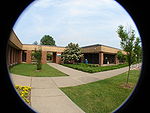St. Cecilia Academy (Nashville, Tennessee)
1860 establishments in TennesseeCatholic secondary schools in TennesseeEducational institutions established in 1860Girls' schools in TennesseeRoman Catholic Diocese of Nashville ... and 2 more
Schools in Nashville, TennesseeTennessee school stubs
St. Cecilia Academy is a private, Roman Catholic, all-female high school in Nashville, Tennessee. Founded in 1860, it is located in the Roman Catholic Diocese of Nashville.
Excerpt from the Wikipedia article St. Cecilia Academy (Nashville, Tennessee) (License: CC BY-SA 3.0, Authors).St. Cecilia Academy (Nashville, Tennessee)
Harding Pike, Nashville-Davidson
Geographical coordinates (GPS) Address Phone number Website Nearby Places Show on map
Geographical coordinates (GPS)
| Latitude | Longitude |
|---|---|
| N 36.132222222222 ° | E -86.842777777778 ° |
Address
The Dominican Campus
Harding Pike 4210
37205 Nashville-Davidson
Tennessee, United States
Open on Google Maps







